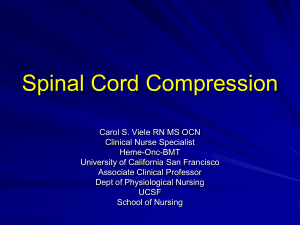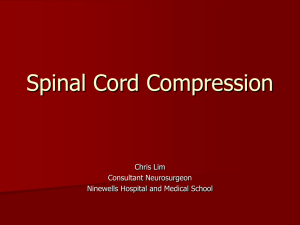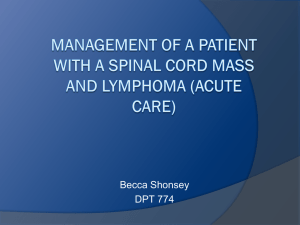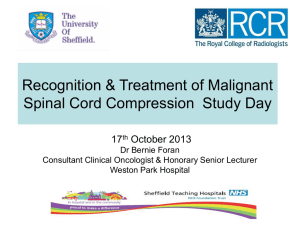Case Study - UCLA K30 Program
advertisement
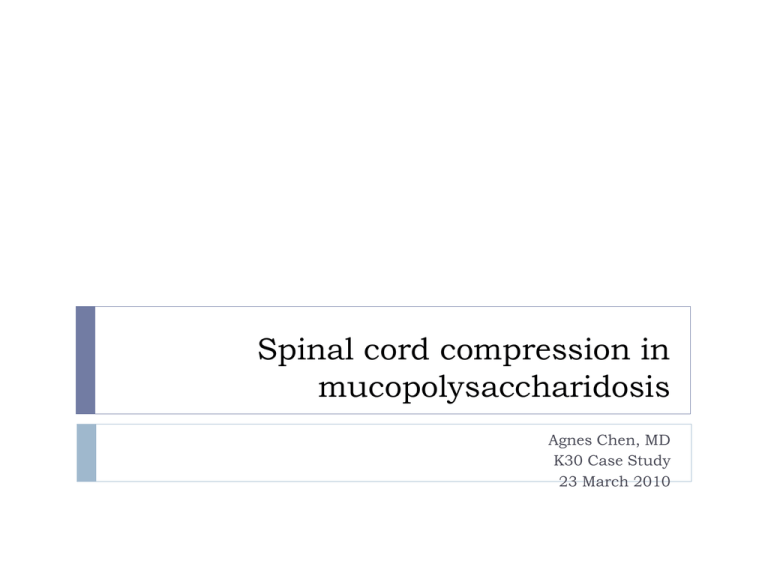
Spinal cord compression in mucopolysaccharidosis Agnes Chen, MD K30 Case Study 23 March 2010 9 year old girl with MPS I Diagnosed at age 2 Intravenous enzyme replacement therapy since dx Over the last two months has started tripping and falling Mother notes intermittent “tremors” of both legs Increased toe-walking Last week, numbness in arms and legs which went away after 30 minutes Denies bowel or bladder symptoms Physical exam VSS, Height: 102cm, Weight: 24.5kg, BMI: 23.5, OFC: 60cm HEENT: facial features of mucopolysaccharidosis, moderate corneal clouding, hearing aids in both ears, gingival hypoplasia, large tongue Neck: short, limited range of motion, no TTP Chest: CTAB, RRR, nl S1, S2 Back: slight kyphosis, no scoliosis Abd: soft NT, ND, no HSM Ext: symmetric shortening, joint widening, flexion contractures in fingers Neurological exam Alert, talkative, cooperative, orientedx3 CN: PERRL, EOMI, full visual fields, no facial weakness, large tongue which is midline Motor: increased tone in both legs, spastic in nature, mild decrease in strength in both legs DTRs: 3+ at biceps, triceps and knees, several beats of clonus at both ankles Sensation: intact to light touch and pinprick, no level Coor: No dysmetria on finger to nose Gait: toe-walking, spastic gait Imaging MRI: Upper cervical spinal stenosis with cord compression, partial occipitalization of C1 Flex-ex x-rays: 4mm of motion between C1 and C2 •Severe, diffuse cervical cord compression with signal change •Odontoid dysplasia •Dural thickening Intrathecal enzyme replacement vs. neurosurgical intervention Proposed surgery: Suboccipital craniectomy C1-C2-C3 decompressive laminectomy Possible duraplasty Cardiology pre-op eval 1st degree heart block with PR of 250ms Mildly thickened mitral and aortic valves EF: 67%, moderate posterior wall and septum thickening Dobutamine echo: no infarct or ischemia with excellent ventricular function Holter: normal, no dropped beats Overall good function but concern for the development of advanced AV block at the time of anesthesia What causes the spinal cord compression in mucopolysaccharidosis? Bony vertebral abnormalities Thickening of spinal ligaments Thickening of the meninges Intrathecal enzyme replacement would theoretically only treat the last cause “Standard of care” is decompressive laminectomy Only about 20 published cases MPS patients are risky surgical candidates: Airway: very distorted anatomy, many reports of emergent tracheostomies Lung: obstructive and restrictive disease Cardiac: arrhythmias, valvular and coronary artery disease Two case reports of recurrence of surgery One case report of cervical myelopathy presenting at age eight, after receiving a bone marrow transplant at age 2 Intrathecal enyzme replacement therapy for MPS I: animal data Challenges with intrathecal enzyme replacement therapy for spinal cord compression in MPS Thickening of extradural components is probably a major contributor to compression; this is not expected to respond to IT ERT Long-standing glycosaminoglycan storage can lead to permanent tissue damage and fibrosis, which may not respond to therapy Early treatment and prevention of damage may be more achievable, but would require very long-term controlled studies Spine MRI as an outcome measure MRI can’t distinguish between dural thickening and extradural thickening May not be sensitive enough to assess effects of intrathecal enzyme replacement Due to rapid progression of her symptoms, parents opted for decompressive surgery






